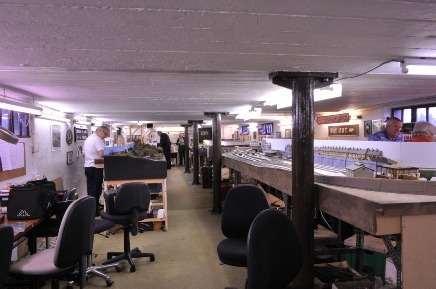Visiting one of the oldest model railway clubs in Coventry
“We are just big boys,” Brian Mears, a committee member of the Coventry Model Railway Club, said with a calm proud smile.
The Coventry Model Railway Club was established in 1955 by members keen on building model railway layouts. There are 40 members nowadays and it opens every Tuesday and Thursday evenings, with Saturdays booked for members’ meetings. It is hidden in a warehouse by the Coventry Canal Basin. I climbed the wooden stairs, knocked on the door, and Brian opened the door for me. The room is small, but big enough to store multiple extravagant layouts. One member was making mini models with a microscope, while some were fixing panels and cables on a layout turned upside down. Brian has been with joined the club for 11 years. He started to buy models and build his own railway like other members after he retired. He recalled, “I’m mad on trains. I worked on trains when I left school. I used to drive in London, Manchester, and Liverpool. All my life, since the age of 10, I have been interested in trains.”
He is turning 82 next month, and the youngest member is 9.
“The train is my life.” He described the model railways as “big boy toys”, but are deceivingly sophisticated. When I asked him to explain the electronic engineering of the layouts, he laughed and told the members next to him, “She got me.” In a half-built layout due to be exhibited in a show next year, there are two control panels called JMRI (Java Model Railroad Interface) and RocRail. The club members design and write the programme, and feed it into the computer. Then, five trains can run on the tracks automatically at the same time. They can also swap the track pieces around to change the layouts.Automation has brought more possibilities for the layouts. For example, the model trains can whistle and make sounds homologous to steam engines and can be controlled on phones through DCC (digital control command).
Everybody has a specialist job in the club. Some people do the electrics, some do the scenery. We all learn how to do things here.
The layouts are also highly artistic and delicately built. Brian showed me a replica of the 1930s Trowbridge train station, which is his favourite in the club. It is one of the largest layouts in the room. A miniature man in a suit stands with hands on hips and crossing legs on the platform, leaning on his wooden suitcase. The impatience of the passengers, exhaustion of the coal workers, and exhilaration of families reuniting are so vivid they convey even the emotion of the original picture hung on the wall. Everyone seemed very proud of this layout. One member went towards the control panel when I was taking pictures. With just a few clicks, a railway turntable rotated, and the door of a maintenance warehouse automatically opened for a train to get inside.
“Everybody has a specialist job in the club. Some people do the electrics, some do the scenery. We all learn how to do things here.” Brian explained, “When we don’t know how to do things, we ask somebody and somebody will know. This is how we operate.”
“I don’t do that, that’s beyond me,” he looked at the computer next to him and laughed again. “I do scenery and build the tracks. I’m just the general dogsbody.” He added that the Trowbridge model was built before his time, and the one who built it has unfortunately passed. With three kilometres of wires, four people control it at the same time to show four different train movements. “Obviously Trowbridge has changed a lot. Probably some building has been knocked down,’ he said.
Models can freeze time, but they are ever-changing. The club members always expand and re-design the layout and repair them when anything goes wrong. They sell the layouts and fix the sold ones too.
He stressed, “There is always something to do for modelling. It never finishes.”
He observed that they have had more members since COVID. Although the membership fee is tiny, memberships are crucial as the model railways are “expensive toys”. He could not estimate how much he has invested in this hobby, but he did not mind. “I have been saving since [I was] 13,” he said. He wanted to have more new and young members, and the Saturday afternoon meeting has allowed more students to join. However, he was content with the current size of the club. He happily complained, “It gets noisy and crowded because of the young ones. They are too noisy.”
“Be quiet,” he turned and told a younger member, who studied Physics at Warwick before.
Before I left, a club member invited me for tea in the little kitchen of the room. Then, another one joked, “You can’t have it. There is whisky.”

Comments (1)
Hi, I am disabled and live in Coventry. Is there access to your club site? I am just starting railways moddeling again after a 50 gap, I’ve decided on N guage. I will be struggling with the wiring due to my disability would somebody be able to help. Sorry for all the questions, kind regards, Paul